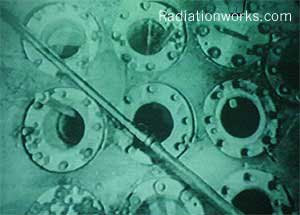
This one is pretty close to home. Fermi 1 still sits right next to Fermi 2. I walk right by the building every morning. As with all of the reactors up to this point in time that have experienced nuclear events, Fermi 1 was also an experimental 94-MW reactor. In fact, Fermi 1 was one of the first FBR reactors ever build. Also, it was cooled with molten sodium, making it a LMFBR (refer to my prior post on reactor types). The liquid metal would be its downfall, however, as no one was experienced in designing systems to contain and distribute liquid metal at the time. It is far more common now with many large-scale solar power generators using liquid metal (typically sodium) as the primary coolant.
There are no more FBRs in operation in the U.S. although they are quite common overseas. A primary advantage of FBRs is that they produce more fissile Pu-239 than U-235 that is burned. The Pu-239 can then be used for fission in nuclear power or for military applications. It is a very good design for countries that have very little indigenous uranium in the ground, thereby having to import it at the expense of monetary assets and national security. A downside of LMFBRs is that sodium reacts chemically with water*, and is known to leak no matter what is attempted. After all, sodium, Na, is a bit bigger than the oxygen atom, but far smaller than the H2O molecule.
On the morning of October 5, 1966, as the reactor was being brought up to full power, the reactor coolant temperature became unusually high. The power increase was halted, and it was noted that two fuel assemblies were over 700F when they should have been at 580F. 10 minutes later, radiation alarms sounded. The reactor was shut down immediately in what is known as a reactor SCRAM. SCRAM** is an old acronym and is typically no longer used. Instead, the term trip is used, as in "the reactor has been tripped." But they called it SCRAM back in the 80's:
More than a month later, a microphone was inserted into the reactor core listening while the sodium was being pumped through the core. A metallic clapping sound was heard. Four damaged fuel assemblies were removed but it was well into 1967 already. Interestingly, this event cause the basic invention of the arthroscope which is now common in many medical procedures as it is minimally invasive - arthroscopic surgery. The Fermi 1 device certainly wasn't small, but was necessary to physically look into the reactor core. It was discovered that a metallic piece that looked like a crushed beer can was wedged and blocked a coolant nozzle. I can only imagine that every construction worker broke out in a sweat during this time. "Hey - who left a beer can in the reactor?" Actually, it was not a beer can at all, but part of a flow deflector that was put in during construction but was not in any blueprint, procedure or drawing whatsoever. Someone had installed it without any design consideration. Since the flow was a high-speed liquid metal, it simply got sheared off due to the viscous stress on it. I'm surprised it lasted as long as it did.
In any case, the plant was back in operation in June of 1970 and ran for a few years. It was refused a license renewal in 1972 by the Atomic Energy Commission and was shut down. Even after the nuclear shutdown, however, an oil-fired boiler was built and the Fermi 1 turbine generated electricity during peak demand in the summer. The oil-fired boiler was dismantled in the 1980's. Fermi 1 is still going through the decommissioning process today. At some point, there will be nothing left of it as the remaining pieces are sold off for scrap. I'm glad I got the opportunity to tour the Fermi 1 complex, albeit is is mostly gutted now. The biggest lesson learned from the Fermi 1 event is, of course, that design control must be strictly kept. Period. Nothing goes in that is not on paper. Also, the need was apparent for a way to monitor the core during and after an accident condition. This is now commonplace in the nuclear industry, but it took Three Mile Island to solidify this need in federal regulations under the NRC. During my training week here at Fermi 2, one of the modules that I was tested on was called the FME protocol. FME stands for Foreign Material Exclusion. When valves, pipes or pumps are opened up for replacement of maintenance, great care is written into tight procedures to make sure that foreign material does not get into the system.
* In 1970, a high-pressure sodium pipe burst. Right after that happened, a water pipe burst also. The two came into contact and an explosion ensued. Fortunately no one was hurt.
** SCRAM is an old acronym standing for Super-Critical Reactor Axe Man. This was literally a guy with an ax that would cut a rope holding up control rods in the first nuclear reactor - the reactor pile known as CP-1 in Chicago, IL. It was a safety measure written into the emergency procedure, albeit it was just one of several safety mechanisms. There are no ropes holding up control rods today. Thank goodness...
Trivia: Specialized operators that went into the top of the reator for maintenance wore special suits pressurized with air (so no infiltration, just exfiltration) and cooled with liquid nitrogen. The suits were very elaborate and these operators were called "reactornauts."
Previously:
The Fermi Chronicles - Part 18: Nuclear Events - SL-1 Event, Idaho, 1961
The Fermi Chronicles - Part 17: Nuclear Events - Windscale, UK, 1957
The Fermi Chronicles - Part 16: Nuclear Events - Chalk River, CAN, 1952
The Fermi Chronicles - Part 15: The Nuclear Business Model
The Fermi Chronicles - Part 14: Neutron Moderation
The Fermi Chronicles - Part 13: Nuclear Reactor Types
The Fermi Chronicles - Part 12: Generating Electricity
The Fermi Chronicles - Part 11: Worldwide Uranium Availability
The Fermi Chronicles - Part 10: Utilizing Nuclear Reactions To "Breed" More Fuel
The Fermi Chronicles - Part 9: Nuclear Fission
The Fermi Chronicles - Part 8: Neutron Interaction
The Fermi Chronicles - Part 7: Radioactive Decay and Half-Life
The Fermi Chronicles - Part 6: Atomic Structures
The Fermi Chronicles - Part 5: Nuclear Waste Storage
The Fermi Chronicles - Part 4: Radiation Types and Radiation "Dose"
The Fermi Chronicles - Part 3: Radiation Types
The Fermi Chronicles - Part 2: A week of training
The Fermi Chronicles - Part 1: The alpha post












 Out of those 104 plants, 69 are PWRs, while 35 are BWRs. All of the 104 plants run on 65 sites throughout the U.S. That means many sites have more than one plant, which makes licensing through the NRC easier as the geological survey and environmental impact study are already done. This trend will continue for cost reasons. Fermi 3 is proposed to be built on the same site as Fermi 2. Here's where nuclear reactors are located throughout the world:
Out of those 104 plants, 69 are PWRs, while 35 are BWRs. All of the 104 plants run on 65 sites throughout the U.S. That means many sites have more than one plant, which makes licensing through the NRC easier as the geological survey and environmental impact study are already done. This trend will continue for cost reasons. Fermi 3 is proposed to be built on the same site as Fermi 2. Here's where nuclear reactors are located throughout the world: Now onto the good tech stuff. First on tap, the PWR. PWRs were designed specifically for the nuclear naval fleet but have been adopted throughout the world for civilian electrical power generation. There are more than 230 PWRs operating today thought the world. The unique feature of the PWR is that no boiling occurs in the nuclear core as the cooling water is kept above 2,300 psia. That is really high pressure! That very hot (600F) water then goes through a heat exchanger where it boils water in a different loop. Here's a good
Now onto the good tech stuff. First on tap, the PWR. PWRs were designed specifically for the nuclear naval fleet but have been adopted throughout the world for civilian electrical power generation. There are more than 230 PWRs operating today thought the world. The unique feature of the PWR is that no boiling occurs in the nuclear core as the cooling water is kept above 2,300 psia. That is really high pressure! That very hot (600F) water then goes through a heat exchanger where it boils water in a different loop. Here's a good  One of the big advantages of the PWR is that all contamination remains in the containment building, and doesn't work its way around the turbine, condenser, pumps, etc. Thus, outside of containment, it is easier to maintain the equipment during operation. The disadvantage is the high pressure that the primary coolant water must be kept at, increasing the chance that a seal or pipe will cut loose some day. Thus the need for high maintenance and monitoring standards. The double coolant loop is more expensive than the BWR design, and the primary coolant loop is seeded with boric acid to moderate the nuclear reaction. Boric acid is highly corrosive. Also, the uranium fuel is enriched to 5-7%, making the fuel a lot more expensive than that used in BWRs that is enriched to only about 3%. Remember that weapons-grade uranium is about 90% enriched.
One of the big advantages of the PWR is that all contamination remains in the containment building, and doesn't work its way around the turbine, condenser, pumps, etc. Thus, outside of containment, it is easier to maintain the equipment during operation. The disadvantage is the high pressure that the primary coolant water must be kept at, increasing the chance that a seal or pipe will cut loose some day. Thus the need for high maintenance and monitoring standards. The double coolant loop is more expensive than the BWR design, and the primary coolant loop is seeded with boric acid to moderate the nuclear reaction. Boric acid is highly corrosive. Also, the uranium fuel is enriched to 5-7%, making the fuel a lot more expensive than that used in BWRs that is enriched to only about 3%. Remember that weapons-grade uranium is about 90% enriched.










